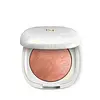What's inside
What's inside
 Key Ingredients
Key Ingredients

 Benefits
Benefits

 Concerns
Concerns

 Ingredients Side-by-side
Ingredients Side-by-side

Talc
AbrasiveMica
Cosmetic ColorantSynthetic Fluorphlogopite
Dimethicone
EmollientOctyldodecyl Stearoyl Stearate
EmollientNylon-12
Isopropyl Palmitate
EmollientPolysorbate 20
EmulsifyingParfum
MaskingMagnesium Aluminum Silicate
AbsorbentLauroyl Lysine
Skin ConditioningCaprylyl Glycol
EmollientSimmondsia Chinensis Seed Oil
EmollientTocopheryl Acetate
AntioxidantOlea Europaea Fruit Oil
MaskingHexylene Glycol
EmulsifyingTin Oxide
AbrasiveSorbitan Stearate
EmulsifyingAcrylamide/Sodium Acryloyldimethyltaurate Copolymer
Emulsion StabilisingIsohexadecane
EmollientPolysorbate 80
EmulsifyingCalcium Sodium Borosilicate
Alumina
AbrasiveCalcium Aluminum Borosilicate
Sorbitan Oleate
EmulsifyingSilica
AbrasiveWater
Skin ConditioningPhenoxyethanol
PreservativeSodium Dehydroacetate
PreservativeAlpha-Isomethyl Ionone
PerfumingBenzyl Salicylate
PerfumingCoumarin
PerfumingLimonene
PerfumingLinalool
PerfumingCI 77891
Cosmetic ColorantCI 77491
Cosmetic ColorantCI 77492
Cosmetic ColorantCI 77499
Cosmetic ColorantCI 15850
Cosmetic ColorantTalc, Mica, Synthetic Fluorphlogopite, Dimethicone, Octyldodecyl Stearoyl Stearate, Nylon-12, Isopropyl Palmitate, Polysorbate 20, Parfum, Magnesium Aluminum Silicate, Lauroyl Lysine, Caprylyl Glycol, Simmondsia Chinensis Seed Oil, Tocopheryl Acetate, Olea Europaea Fruit Oil, Hexylene Glycol, Tin Oxide, Sorbitan Stearate, Acrylamide/Sodium Acryloyldimethyltaurate Copolymer, Isohexadecane, Polysorbate 80, Calcium Sodium Borosilicate, Alumina, Calcium Aluminum Borosilicate, Sorbitan Oleate, Silica, Water, Phenoxyethanol, Sodium Dehydroacetate, Alpha-Isomethyl Ionone, Benzyl Salicylate, Coumarin, Limonene, Linalool, CI 77891, CI 77491, CI 77492, CI 77499, CI 15850
Water
Skin ConditioningDimethicone
EmollientIsohexadecane
EmollientEthylhexyl Methoxycinnamate
UV AbsorberPhenyl Trimethicone
Skin ConditioningMica
Cosmetic ColorantPolymethylsilsesquioxane
Caprylyl Dimethicone Ethoxy Glucoside
EmulsifyingTitanium Dioxide
Cosmetic ColorantCocoglycerides
EmollientButylene Glycol
HumectantSorbitan Isostearate
EmulsifyingDimethicone Crosspolymer
Emulsion StabilisingAluminum/Magnesium Hydroxide Stearate
Emulsion StabilisingGlycerin
HumectantPhenoxyethanol
PreservativeSodium Chloride
MaskingCaprylic/Capric Triglyceride
MaskingZinc Stearate
Cosmetic ColorantSilica Silylate
EmollientPotassium Sorbate
PreservativeSodium Dehydroacetate
PreservativeTocopheryl Acetate
AntioxidantDisodium EDTA
Carthamus Tinctorius Seed Oil
MaskingAloe Barbadensis Leaf Extract
EmollientRubus Idaeus Leaf Extract
Skin ConditioningCI 77891
Cosmetic ColorantCI 77491
Cosmetic ColorantWater, Dimethicone, Isohexadecane, Ethylhexyl Methoxycinnamate, Phenyl Trimethicone, Mica, Polymethylsilsesquioxane, Caprylyl Dimethicone Ethoxy Glucoside, Titanium Dioxide, Cocoglycerides, Butylene Glycol, Sorbitan Isostearate, Dimethicone Crosspolymer, Aluminum/Magnesium Hydroxide Stearate, Glycerin, Phenoxyethanol, Sodium Chloride, Caprylic/Capric Triglyceride, Zinc Stearate, Silica Silylate, Potassium Sorbate, Sodium Dehydroacetate, Tocopheryl Acetate, Disodium EDTA, Carthamus Tinctorius Seed Oil, Aloe Barbadensis Leaf Extract, Rubus Idaeus Leaf Extract, CI 77891, CI 77491
 Reviews
Reviews

Ingredients Explained
These ingredients are found in both products.
Ingredients higher up in an ingredient list are typically present in a larger amount.
Ci 77491 is also hydrated iron III oxide. It's sole purpose is to give a red/pink hue to products.
Iron III oxides are classified as inorganic chemicals for coloring.
Synthetically created Ci 77491 is considered safer than those naturally found. This is because the synthetically created version may contain less impurities. Iron oxides are generally non-toxic and non-allergenic.
Learn more about CI 77491Ci 77891 is a white pigment from Titanium dioxide. It is naturally found in minerals such as rutile and ilmenite.
It's main function is to add a white color to cosmetics. It can also be mixed with other colors to create different shades.
Ci 77891 is commonly found in sunscreens due to its ability to block UV rays.
Learn more about CI 77891Dimethicone is a type of synthetic silicone created from natural materials such as quartz.
What it does:
Dimethicone comes in different viscosities:
Depending on the viscosity, dimethicone has different properties.
Ingredients lists don't always show which type is used, so we recommend reaching out to the brand if you have questions about the viscosity.
This ingredient is unlikely to cause irritation because it does not get absorbed into skin. However, people with silicone allergies should be careful about using this ingredient.
Note: Dimethicone may contribute to pilling. This is because it is not oil or water soluble, so pilling may occur when layered with products. When mixed with heavy oils in a formula, the outcome is also quite greasy.
Learn more about DimethiconeIsohexadecane is added to enhance texture, emulsify, and to help cleanse. It is an isoparrafin. It is a component of petrolatum.
Due to its large size, Isohexadecane is not absorbed by the skin. Instead, it sits on top and acts as an emollient. Emollients help keep your skin soft and smooth by trapping moisture within.
Isohexadecane is often used in products designed to help oily skin. It is lightweight and non-greasy while helping to moisturize. When mixed with silicones, it gives a product a silky feel.
Learn more about IsohexadecaneMica is a naturally occurring mineral used to add shimmer and color in cosmetics. It can also help improve the texture of a product or give it an opaque, white/silver color.
Serecite is the name for very fine but ragged grains of mica.
This ingredient is often coated with metal oxides like titanium dioxide. Trace amounts of heavy metals may be found in mica, but these metals are not harmful in our personal products.
Mica has been used since prehistoric times throughout the world. Ancient Egyptian, Indian, Greek, Roman, Aztec, and Chinese civilizations have used mica.
Learn more about MicaPhenoxyethanol is a preservative that has germicide, antimicrobial, and aromatic properties. Studies show that phenoxyethanol can prevent microbial growth. By itself, it has a scent that is similar to that of a rose.
It's often used in formulations along with Caprylyl Glycol to preserve the shelf life of products.
This ingredient is a preservative with antimicrobial properties. It is the sodium salt of dehydroacetic acid.
It is especially effective at preventing bacterial and fungal growth in low concentrations.
Tocopheryl Acetate is AKA Vitamin E. It is an antioxidant and protects your skin from free radicals. Free radicals damage the skin by breaking down collagen.
One study found using Tocopheryl Acetate with Vitamin C decreased the number of sunburned cells.
Tocopheryl Acetate is commonly found in both skincare and dietary supplements.
Learn more about Tocopheryl AcetateWater. It's the most common cosmetic ingredient of all. You'll usually see it at the top of ingredient lists, meaning that it makes up the largest part of the product.
So why is it so popular? Water most often acts as a solvent - this means that it helps dissolve other ingredients into the formulation.
You'll also recognize water as that liquid we all need to stay alive. If you see this, drink a glass of water. Stay hydrated!
Learn more about Water